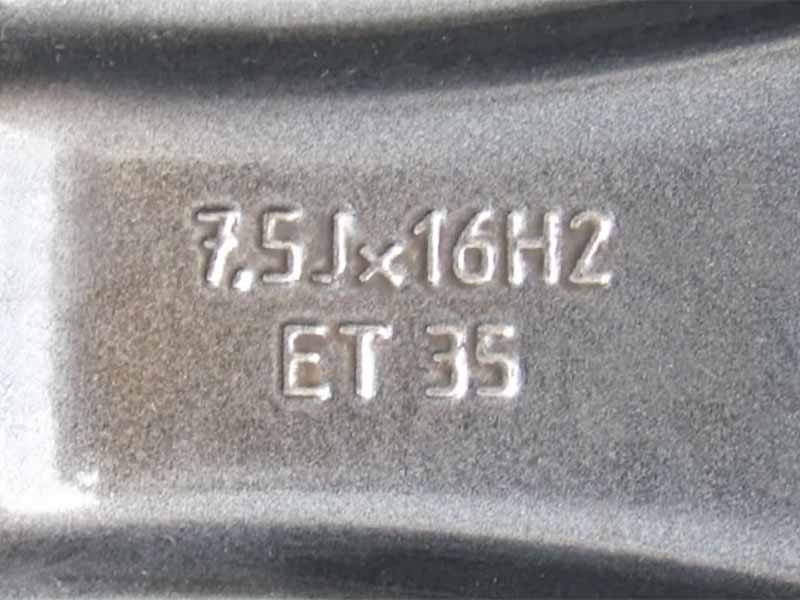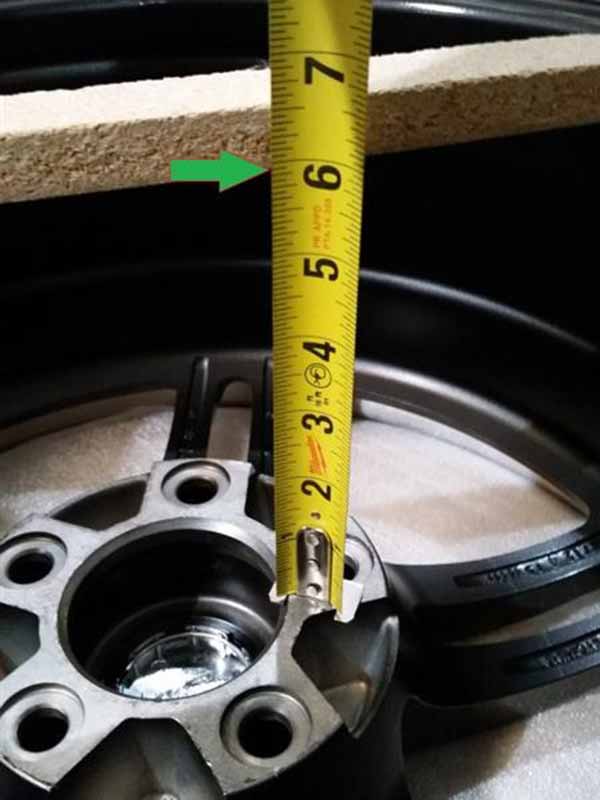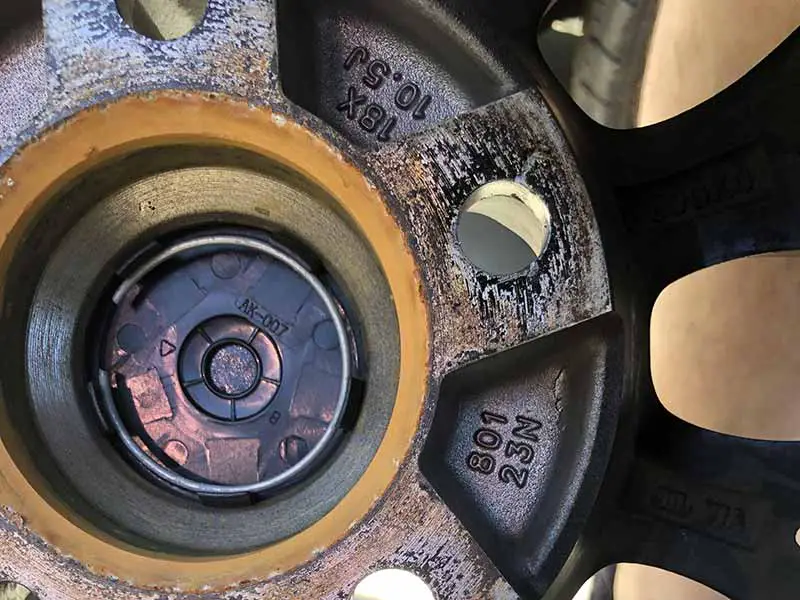Are you considering a wheel upgrade for your ride, but feeling overwhelmed by the technical jargon? Look no further!
In this comprehensive guide to backspacing and wheel offset, we’ll break down everything you need to know about these two critical measurements, in a simple and easy-to-understand way.
Offset Vs Backspacing
Offset and backspacing are two similar measurements for wheel fitment as they relate to the wheel mounting surface on a vehicle.
Offset refers to the distance between the wheel’s centerline and its mounting surface.
Backspacing is the distance from the mounting surface to the inner face of the wheel.
Whether you’re looking to enhance your vehicle’s performance, improve its appearance, or simply ensure a proper fit, this article will be your one-stop shop for all things wheel-related. So buckle up, and let’s dive into the fascinating world of offsets and backspacing!
Let’s take a closer look.

What Is Offset On Wheels
Offset is a term used to describe the distance between the center of a wheel and its mounting surface. This measurement is important because it affects how the wheel fits on your vehicle, how it looks, and how it performs. There are three main types of offsets: negative, zero, and positive. Understanding each type will help you make an informed decision when choosing new wheels for your ride.
Negative Offset
Negative offset is when the mounting surface is closer to the inside of the wheel, which means the wheel sticks out further from the vehicle. This type of offset is common on trucks and off-road vehicles because it provides more stability and clearance for larger tires. While it can look cool, keep in mind that having a negative offset can put extra stress on your vehicle’s suspension and steering components, and may affect handling.
Zero Offset
Zero offset means that the mounting surface is exactly in the center of the wheel. This creates a balanced stance for your vehicle and can be found on many stock wheels. It doesn’t change the vehicle’s handling or put any additional strain on the suspension components. In general, zero offset wheels are a safe choice for most drivers.
Positive Offset
Positive offset occurs when the mounting surface is closer to the outside of the wheel. This pushes the wheel further in towards the vehicle. Positive offset wheels are often seen on front-wheel-drive cars and some newer trucks. These wheels can provide a cleaner, tucked-in appearance, but it’s essential to ensure they don’t interfere with your vehicle’s suspension or fender clearance.
Negative Offset Wheels
Negative offset wheels are popular among truck and off-road enthusiasts because they provide a more aggressive, rugged look. These wheels help widen the vehicle’s track, which can improve stability and traction. However, they may also increase the risk of rubbing or interference with suspension components, so be careful when choosing extreme negative offset wheels.
Positive Offset Wheels
Positive offset wheels are more common on modern vehicles, especially those with front-wheel drive. They give a clean, flush look to your car or truck while still providing proper clearance for suspension components and fenders. Positive offset wheels can improve handling and reduce steering effort, but it’s important not to choose too high of an offset, as this can cause rubbing or other issues.
How To Measure Wheel Offset
To measure wheel offset, you’ll need a straight edge, like a ruler or a level, and a measuring tape. First, lay the straight edge across the back of the wheel, so it’s touching both edges of the rim. Then, use the measuring tape to measure the distance from the mounting surface to the straight edge. This distance is the wheel offset. Keep in mind that negative offset will have a larger measurement, while positive offset will have a smaller measurement.
What Is Backspacing On Wheels
Backspacing is another measurement used to describe how a wheel fits on a vehicle. It refers to the distance from the mounting surface of the wheel to the inner edge of the rim. Backspacing helps you determine if a wheel will fit without rubbing on suspension components or fender wells, and it’s especially important when upgrading to larger wheels or tires.
How To Measure Wheel Backspacing
To measure wheel backspacing, you’ll need the same tools as for measuring wheel offset: a straight edge and a measuring tape. Place the wheel face-down on a flat surface. Lay the straight edge across the back of the wheel, so it’s touching both edges of the rim. Use the measuring tape to measure the distance from the mounting surface to the straight edge. This distance is the wheel backspacing.

Wheel Offset Calculator
Offset can be easily calculated if you know the width of your wheel and the backspacing. Backspacing is the measurement from the back face of the rim to the mounting surface.
Wheel Offset Comparison Tool
This wheel offset comparison tool is a helpful tool to make it easy to figure out the change in position of your wheels if you change the offset. It will calculate the change in position of the inner and out faces of your wheel based on changes to wheel width and offset.
Just enter your current wheel width (in inches) and offset (in mm), and the calculator will give you amount of inner and outer change to the wheel position (in mm).
You’ll need to measure the clearance between your suspension and fender to determine whether you’ll have enough room for the new rims you’re considering on your car or truck. You’ll also need to account for steering angle from lock to lock and suspension compression.
If you don’t feel completely comfortable making the decision on your own, we recommend contacting a wheel retailer or wheel manufacturer to determine what’s a good choice for your vehicle and needs.
Wheel Backspace Calculator
This wheel backspace calculator converts wheel width and offset to a backspacing measurement in inches. You can often find the width and offset on the backside of your wheel.
How To Convert Backspacing To Offset
Converting backspacing to offset is a useful skill when comparing wheel options or when using a wheel calculator that only provides one of the measurements. To convert backspacing to offset, follow these steps:
- Measure the overall width of the wheel (from the outer edge to the inner edge of the rim).
- Divide the overall width by 2 to find the wheel’s centerline.
- Measure the wheel backspacing.
- Subtract the centerline from the backspacing measurement.
- If the backspacing is greater than the centerline, you have a positive offset; if it’s smaller, you have a negative offset. The difference between the two measurements is the offset value.
For example, let’s say you have a wheel with an overall width of 10 inches and a backspacing of 6 inches. The centerline would be 5 inches (10 divided by 2). Since the backspacing is greater than the centerline (6 inches > 5 inches), you have a positive offset. The difference between the two measurements (6 inches – 5 inches) is 1 inch, so the offset is +1 inch.
How To Convert Offset To Backspacing
Converting offset to backspacing is helpful when you have the offset measurement and need to determine the backspacing for a particular wheel. Here’s how to convert offset to backspacing:
- Measure the overall width of the wheel (from the outer edge to the inner edge of the rim).
- Divide the overall width by 2 to find the wheel’s centerline.
- Determine the wheel offset (make sure to use the same unit of measurement, such as inches or millimeters, as the wheel width).
- If you have a positive offset, add the offset value to the centerline; if you have a negative offset, subtract the offset value from the centerline.
- The resulting value is the backspacing measurement.
For example, let’s say you have a wheel with an overall width of 8 inches and a positive offset of 2 inches. The centerline would be 4 inches (8 divided by 2). Since the offset is positive, add the offset value to the centerline (4 inches + 2 inches), which equals 6 inches. Therefore, the backspacing for this wheel is 6 inches.
Understanding Wheel Offset and Backspacing Together
Now that you’re familiar with both wheel offset and backspacing, it’s important to understand how they work together to determine the proper fitment of a wheel on your vehicle. The two measurements are closely related, and changes in one will usually affect the other.
If you increase the offset, the wheel will move closer to the vehicle, and the backspacing will also increase. Conversely, if you decrease the offset, the wheel will move further away from the vehicle, and the backspacing will decrease. By considering both measurements, you can make sure your new wheels and tires will fit your vehicle without causing any rubbing or clearance issues.

Choosing the Right Offset and Backspacing for Your Vehicle
When selecting new wheels, it’s important to choose the correct offset and backspacing to maintain proper vehicle handling, performance, and appearance. Before purchasing, consider your driving style, your vehicle’s purpose (daily driver, off-roading, racing), and the desired appearance (flush, tucked, or aggressive).
For most drivers, staying within the manufacturer’s recommended offset and backspacing range is a safe bet. However, if you’re looking to customize your vehicle or upgrade to larger wheels and tires, understanding these measurements and using calculators will help you find the right fit. Always test fit new wheels before installation, and remember that aftermarket wheels may require additional modifications, such as fender rolling or suspension upgrades, to ensure proper clearance and prevent rubbing.
Resources
Below are some links you may find helpful when learning about tires
Final Thoughts
Understanding the concepts of wheel offset and backspacing is important for anyone looking to upgrade their wheels. We hope this guide has shed some light on these critical measurements and helped you feel more confident when it comes to making decisions about your wheels and tires.
If you’re hungry for more knowledge or want to explore a wide range of wheel and tire knowledge, be sure to visit homepage, your ultimate resource for all things wheel and tire related.
Good luck and happy motoring.





